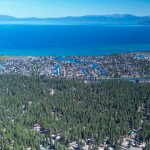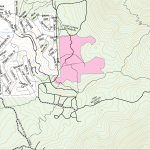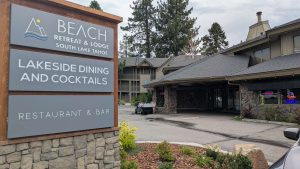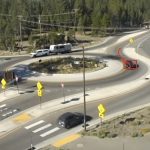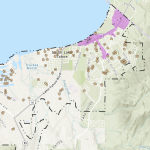Budget workshop, transit JPA and bears: city council updates
SOUTH LAKE TAHOE, Calif. – On Tuesday, August 26, city council held their budget workshop for the next fiscal year, decided on if they’d fund the South Tahoe Transit Joint Powers Authority (JPA) and heard public comment about bear #753. They also discussed the vacancy rate at the city in accordance with AB 2561.
Public comment
Several public comments came in support of bear #753, which the California Department of Fish and Wildlife (CDFW) has ordered to be euthanized. This resulted in an incident involving the bear, CDFW and the BEAR League last week. Residents spoke about their efforts to haze bears and clean their trash, which they felt the CDFW had not adequately informed people about.
Toogee Sielsch spoke about that incident and said the “folks that spurred on the flash mob” obfuscate the jobs of the CDFW and Nevada Department of Wildlife. “The inference that the front-line bear biologists working for both these agencies are bloodthirsty bear-killers is as far from the truth as possible,” he said.
Sielsch also called a councilmember’s request to not have bears killed within city limits as “myopic” and said it could lead to injuries that the city would be liable for in future human-bear conflicts. David Jinkens has been outspoken about his stance on killing bears within city limits to both South Tahoe Now and the Tribune.
According to city manager Joe Irvin, the CDFW will be presenting at the October 21 council meeting.
Angie Reagan of Peace Love Tahoe asked for the council to include “Tahoe for All” in their strategic priorities, advocating for disabled people, seniors, BIPOC and LGBTQ+ communities in Tahoe.
One attendee spoke to the Heavenly annexation attempts and suggested that a public-private partnership with the city in conjunction with a sustainable tourism app would make them more amenable to negotiation in the future.
Vacancies in city staff
In compliance with AB 2561, Irvin presented on the vacancies in city positions. Currently, there are 12.34 vacant full-time positions at the city, with a vacancy rate of 5.58% and a retention rate of 92.23%.
Vacancy rates above 20% require a deeper dive, and the bargaining unit for the Police Employees Association (PEA) had a 20.59% vacancy rate. Irvin explained that the council is currently waiting to approve community service officers for hire. Of the four current candidates, one is moving forward. The vacancy rate is also tied to how the position is allocated for the PEA and training for officers.
Irvin felt that the city was currently compliant to the best of its abilities. He also indicated that this would be a regular report from here on out.
South Tahoe Transit JPA
Earlier this year, the El Dorado County Board of Supervisors ultimately did not choose to fund their one-third portion of the transit JPA, so it currently does not have the funding to operate. The city is currently working with partner agencies and stakeholders on transit improvement, which has been a priority for councilmembers, especially Mayor Pro Tem Cody Bass.
Assistant city manager Hilary Roverud spoke about the headway they’ve made with transit in recent years—the Tahoe Transportation District (TTD) reported more frequent Route 50 service with 30-minute headway. The TTD has also reduced the costs per revenue hour from $275 to $208 in the 2025 fiscal year. There’s also been a total ridership increase in the last year.
The South Shore Transit Management also expanded Lake Link’s service area last year and its weekend hours of operation. Currently, they are seeking out a three-year funding agreement with Douglas County to fund microtransit.
Lastly, the Tahoe Regional Planning Agency’s (TRPA) staff is studying transit services in the region and expects to finish their study by the end of 2026.
Councilmember Keith Roberts asked about the Emerald Bay Transit Pilot Program, and while Roverud said that it was too early for concrete data, there were definitely positive signs.
The council all agreed that they were disappointed in the county’s lack of participation in the program.
Jim Marino, executive director of TTD, said, “This is absolutely a funding issue. The TTD receives very little to no local funds from any entity on the south shore. We rely solely on state and federal funds, and we leverage those funds to the max. If we want to expand transit in the south shore… we need to have a funding source that supplements the state and federal funding.”
Marino went on to say that he felt the JPA was supposed to create a funding source for them and that the service would not increase unless there were funding options over and above current contributions.
Bass asked if Nevada contributed money towards the transit in the area, which Marino clarified that there is not a gas tax or other mechanism assigned to transit in Nevada. However, they do pay for the East Shore Express and pay into TART for Incline Village.
Councilmember Scott Robbins said, “The quality of public transit here just absolutely doesn’t measure up [to other ski towns], not just for tourists but for service workers.” He said he did not feel confident about the system “becoming what it needs to be” through TTD and felt that Nevada and Douglas County’s stake in south shore transit has siphoned away resources. Robbins felt the JPA was a vital part of ensuring transit in the area.
The council debated whether they would appropriate funds and ask El Dorado County to participate again, but ultimately chose to appropriate $150,000 for the JPA. That motion passed unanimously.
City budget
Currently, the city has an all-funds budget of $246.7 million, with a general fund of $67.3 million and Measure S funds at $7.9 million. The general fund has decreased by $2.6 million from last year’s budget due to one-time expenditures for capital improvements. By the end of September, they conservatively project the budget at $1.5 million.
The largest sources of revenue for the city are grants ($25.9 million), the transient occupancy tax ($23.2 million) and sales tax ($21.4 million). The biggest expenditures are building and equipment capital improvement projects such as the rec center ($51.7 million), streets and bike trails ($22.3 million) and non-departmental and debt service payments ($18.7 million).
Approximately 66% of the general fund is spent on personnel costs, with $500,000 toward deferred maintenance needs. There are five new full-time employee positions which is offset by the elimination of 1.5 full-time employee positions.
The finance department proposed their budget for strengthening IT cybersecurity and completing the main financial software upgrade.
The police department proposed their budget for three patrol cars to replace ones at the end of their lives, body-worn and in-car cameras, parking garage painting and lights, supporting POST training standards for police officers and staff allocations for vacation home rental (VHR) enforcement. They also will be addressing ski and snowboard thefts.
The fire department proposed their budget for fuels reduction projects, including securing funding for evacuation routes, establishing a deputy chief of operations, purchasing a new type 1 engine, replacing 3 light-duty vehicles and expanding their prevention division, which includes helping educate on Firewise communities and commercial fire inspection program improvements.
Fire Chief Jim Drennan said that they are ahead of state ordinances on defensible space.
Public works proposed their budget for staffing and contract services such as snow removal with Trella Tahoe, funding equipment including four John Deere graders, one freightliner sander and two trucks, and a capital improvement projects budget for four projects: road rehabilitation, El Dorado Beach revetment, Upper Bijou Drainage and James and Eloise Drainage projects. They plan to dedicate $4 million strictly for paving and sealing roads.
Development services proposed their budget for permit fee revenues and service demand, housing initiatives, program and staffing, area plans, plan review and inspections, planning entitlements, permit tracking software and process improvement and VHR inspections. Director Zachary Thomas said they were on track with integrating what was previously Placemate’s Lease to Locals program.
Lastly, Parks and Recreation proposed their budget for the new rec center, new positions, marketing, special events, parks and forestry, the Bijou Golf Course, Campground by the Lake, Arts, Culture and Tourism Commission and the Parks and Recreation Commission.
Bass also requested that they put aside some funding for becoming part of the National League of Cities, which Irvin said could be covered.
The motion for the budget passed unanimously.
Next city council meeting will be a fairly busy one, including agenda items on the Tahoe Coalition for the Homeless and an emergency shelter, the cannabis tax, midtown area plan discussion and VHR program. It will take place on September 9.
Eli Ramos is a reporter for Tahoe Daily Tribune. They are part of the 2024–26 cohort of California Local News Fellows through UC Berkeley.

Support Local Journalism

Support Local Journalism
Readers around the Lake Tahoe Basin and beyond make the Tahoe Tribune's work possible. Your financial contribution supports our efforts to deliver quality, locally relevant journalism.
Now more than ever, your support is critical to help us keep our community informed about the evolving coronavirus pandemic and the impact it is having locally. Every contribution, however large or small, will make a difference.
Your donation will help us continue to cover COVID-19 and our other vital local news.

